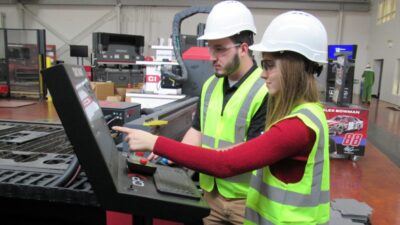If a company’s distributed control system (DCS) is more than 10 years old, it is likely a significant barrier to reaching your goals. But modernized or upgraded properly, the DCS could become vital in achieving and surpassing goals such as enhancing operations and improving productivity while exceeding return on investment (ROI) expectations.
Although vintage distributed control systems (DCS) might continue to operate reliably, facilities that employ them may be lulled into a false sense of security thinking, "Everything is fine." In reality, maintaining the status quo of older DCSs leaves organizations falling behind. When facilities delay or avoid system updates, risks grow. Competitors improve their operations. Personnel leave and organizational expectations change. Dynamic markets require agility and insights older DCSs cannot provide. When updated, DCSs enable facilities to take advantage of recent and powerful technology advances (see Figure 1).
Twenty or 30 years ago, many technologies such as wireless networks, intelligent devices, and of course, the internet, did not exist. These innovations allow modern systems to offer greater reliability and are designed with greater consideration for system interoperability, flexibility, analytics, operator awareness, and alarm management. Perhaps most importantly, features and methodologies supporting cybersecurity and safety have become stronger and more standardized over the years.
Protect with enhanced cybersecurity power
Manufacturers designing systems built circa 1990 and 2000 could not anticipate the security issues industries face today. Facilities employing many older systems today do not operate within the security-conscious environment that provide the agility and lifecycle management structures necessary to respond to new and frequent threats. Putting strategies in place for those systems can be extremely difficult.
In many cases, it is impossible to properly secure these older systems. If the team tries to respond to a cyberattack without the right infrastructure and tools, mistakes are probable, expenses are high, and the probable downtime is much longer. Plus, the team would be forced into upgrading to address the security breach in a reactive action rather than through proactive planning.
Conscientious about security policies. Although seemingly cumbersome, security measures must be followed to thwart attackers who count on laziness. The entire organization reduces risk by following procedures that support cybersecurity barriers. But if the procedures are not kept current, the procedures performed by the personnel become useless and the risks increase.
Physical compromise. By establishing and enforcing administrative policies associated with updated technologies, companies can prevent the DCS from falling victim to unauthorized, physical access or exposure to compromised media devices. Current DCSs ease and centralize aspects of physical security with features such as one-click lockdown of network ports and automated disabling of USB access.
Continuous cybersecurity upgrades. Modern DCSs have embedded security upgrade options. Putting off upgrading a vintage DCS to avoid costly downtime might sound good financially short-term, but remember that malware and ransomware attacks cost far more than a simple upgrade. Operating systems do not live forever (see Figure 2). Stop thinking an out-of-date DCS is safe. Some system manufacturers can assist with the plan. When a company upgrades its DCS, demand the new system releases have cyber hardening to provide additional defense-in-depth protection.
Take advantage of information across the Industrial Internet of Things (IIoT)
The IIoT and the technologies that surround it offer profound power to the modern facility. Information distribution, a smart infrastructure, the integration of systems, and the sharing of expertise improve reliability, bring sharper insights, and deliver decision-making power to the right people.
Finding stranded data to improve reliability. Outmoded DCSs do not take full advantage of smart devices that offer information about their health and status. The data is blocked by the system and is not getting to the right people who need to make effective decisions. Not only should data from these devices be used in the DCS for effective control, but moving data up to the enterprise is important in sharing and improving process conditions as well as measuring and driving appropriate business metrics.
Enhancing digital infrastructure for additional measurements and improved reliability. To set realistic production goals and optimize the process, a facility must understand how well the current process runs. That knowledge requires diagnostic data in smart devices as well as control performance data from the DCS. Studies estimate most facilities are 30% under-instrumented when it comes to getting relevant information to manage the operation. The good news is the modern digital infrastructure enables users to add information sources easily at the device level. Today’s system controllers and distributed, flexible input/output (I/O) can easily be swapped out of and into a system without re-engineering or finding additional control-room space.
Improving interoperability and integration to get information to the right people for improvements. If the facility includes devices spanning multiple protocols, it’s a good bet the team is communicating with them by employing clumsy gateways and managing multiple databases. Today’s DCSs communicate with all devices in almost any protocol and can provide data easily and securely through OPC UA. Through this flexible communication, the modern DCS enhances and simplifies engineering today and provides more opportunities for growth in the future.
Pulling potential out of the cloud for efficiencies throughout the facility lifecycle. During project execution, the team needs to work as a single unit to deliver on time and on budget. Modern systems offer engineering hosted in the cloud for information sharing and flexibility, including virtual software factory acceptance testing (FAT). At startup and beyond, dynamic simulation in the cloud puts more certain success into training and upgrading. Any improvements to the system can be later safely and efficiently designed and engineered without affecting the live plant. After the facility is up and running, connected services such as remote monitoring through the cloud help keep the system up to date and monitor its health.
Find strong productivity through operational improvements
When people can view and use information wherever they are in the formats they need, they can better respond to the process, make productive decisions faster, and drive operational improvements leading to safety, reliability, and efficiency. Recent advances in DCS foundations employ HTML5 to create an environment where digital workers can view and use data from many sources across the organization. This gives them more ways to visualize information and augment their environment on-the-fly for better real-time results.
Alarm rationalization and visualization. Not only have alarm interfaces improved through the use of color and pattern recognition, but the engineering done in the background has become easier. Alarms are better presented and analyzed to help operators and managers better understand the root causes and plan successful solutions. Conditional alarm strategies are easier to implement and tools are available to operations to drive the proper actions to resolve the condition or shelve alarms.
Operator-tailored interface for more easily acted-on information. Outmoded DCSs require an engineer to configure displays for each operator task. Any display-change requests must wait for the engineer. However, today, an engineer can set up privileges that enable operators to customize portions of their workspace as necessary. For example, an operator using a modern human-machine interface (HMI) might drag and drop a control tag onto an area of the display so it can be monitored during a shift. These interfaces also allow integration at the glass of many types of data and visual information outside the DCS required for the operators to do their job, such as video feeds or electronic logbooks.
Information where and when needed for improved collaboration and decision-making. Data mobility is built into modern DCSs. In fact, equipped with a mobile device, today’s user can take advantage of the wide variety of platforms and have more flexibility to choose the right one for the task. With this capability, users can keep tabs on events from afar and move quickly from knowledge to action as required (see Figure 3). Getting the right information to the right person enables better operational performance.
Opportunities and success in updates
The cost of addressing security, connectivity, and operations is minor compared to the returns obtained by the organization because automation is a lever for business success. The end results of improving automation include distributing information securely and easily to and from the DCS and simplifying operations for stronger productivity.
After updating, the DCS will no longer limit production and efficiency and will enable organizations to move closer to operational certainty. And security and information reach will be flexible enough to take advantage of upcoming opportunities and meet demands from the marketplace for safety and production.
Aaron Crews is director global modernization solutions at Emerson. Edited by Jack Smith, content manager, Control Engineering, CFE Media, [email protected].
MORE ANSWERS
KEYWORDS: Distributed control system
- Although vintage distributed control systems (DCSs) might continue to operate reliably, facilities that employ them may be lulled into a false sense of security.
- Facilities employing older systems do not operate within a security-conscious environment.
- Modern DCSs have embedded security upgrade options.
CONSIDER THIS
Does your plant have a legacy DCS that prevents your company from optimizing operations?



